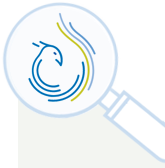Every year, 11 million tonnes of plastic rubbish ends up in the oceans and in 2050, there could be more plastic in the sea than fish. Another alarming aspect is that rising quantities of plastic produced also cause a rise in the quantities of plastic waste that the seas have to deal with. Experts assume that if nothing is done, the amount of plastic entering the sea will quadruple by 2040, which is equivalent to 600 million tonnes. There are already some initiatives that aim to remove plastic from the seas. One of the best-known is definitely Boyan Slat’s The Ocean Cleanup. Contrary to general assumptions, one of the most prominent types of plastic rubbish in the sea (with a share of about 10%) consists of objects left behind, lost or thrown away by the fishing industry – commonly known as “ghost gear”, and this is also the most problematic for wildlife.
Sending plastic rubbish back into the material cycle through recycling
Removing plastic rubbish from the sea is one thing, but what happens to the plastic fished out of the sea? The Dutch start-up Healix has dedicated itself to this issue, sending plastic waste consisting of fibre composites back into the material cycle. Healix recycles PP and HDPE plastics. In doing so, it relies on sea plastic consisting of maritime nets, yarns and ropes, flower nets, bale nets or Big Bags, which are collected by the initiatives The Ocean Cleanup and Adivalor. RIGK is part of this initiative and supplies Healix with materials from its ERDE and RIGK-SYSTEM recovery systems. This allows the raw materials, which can be found in bale nets, for example, to be reused as recyclate to make new products. Thanks to a state-of-the-art process, including cleaning and compounding, Healix sends the plastics back into the cycle as recyclate, thus creating a closed loop.
Common cooperation when collecting, recycling and manufacturing ensures success
Recyclates made of post-consumer fibre composites are interesting as basic materials in production, because they are usually very homogeneous, have long molecular chains and a low melting flow index (MFI) as a result. As an end product in the recycling chain, certified recyclates are extremely close in their properties to newly-produced PP or HDPE polymers. However, the main difference is the reduction in CO2 emissions in comparison to new polymers, which amounts to between 75% and 77%. In this manner, Healix taps additional supplies of raw materials with its system, representing an additional building block on the path away from the linear economy to the circular economy. Thanks to the cooperation between RIGK, the recycling company ADIVALOR and Tama, the largest manufacturer of baling twine in the world, long-term prospects for the process will be secured. For example, under the name Tama Cycle Twine, Tama has launched a new range of round polymer baling twine on the market based on Healix products. Not only does this secure the supply of recyclates, but it also ensures these will be used to make new products - durther information at
Further information:
Geschäftsführung
Jan Bauer
bauer(at)rigk.de
